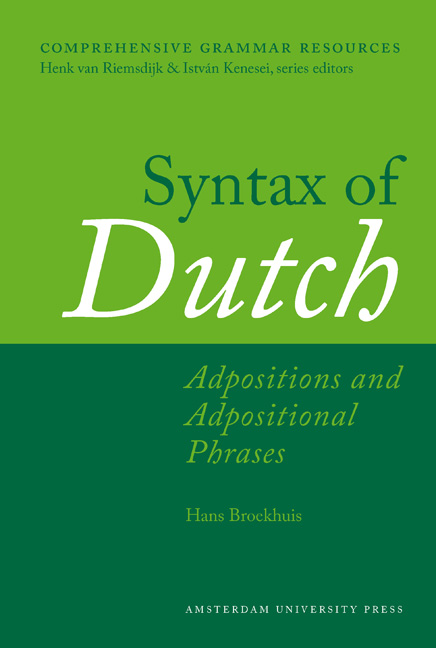Book contents
- Frontmatter
- Contents
- Abbreviations and symbols
- Preface and Acknowledgments
- Introduction
- Chapter 1 Adpositions: Characteristics and Classification
- Chapter 2 Projection of Adpositional Phrases: Complementation
- Chapter 3 Projection of Adpositional Phrases: Modification
- Chapter 4 Syntactic uses of the Adpositional Phrase
- Chapter 5 R-pronominalization and R-words
- Glossary
- Subject Index
- References
- Miscellaneous Endmatter
- Miscellaneous Endmatter
Chapter 2 - Projection of Adpositional Phrases: Complementation
Published online by Cambridge University Press: 10 December 2020
- Frontmatter
- Contents
- Abbreviations and symbols
- Preface and Acknowledgments
- Introduction
- Chapter 1 Adpositions: Characteristics and Classification
- Chapter 2 Projection of Adpositional Phrases: Complementation
- Chapter 3 Projection of Adpositional Phrases: Modification
- Chapter 4 Syntactic uses of the Adpositional Phrase
- Chapter 5 R-pronominalization and R-words
- Glossary
- Subject Index
- References
- Miscellaneous Endmatter
- Miscellaneous Endmatter
Summary
Introduction
This section discusses the complementation of adpositional phrases. Sections 2.1-2.3 will show that, in the core case, the complement of an adposition is a noun phrase: adpositional phrases are not common as complements of adpositions, although there is a small set of prepositions that may occur with them; adjectival phrases acting as the complement of an adposition are extremely rare, if possible at all. Section 2.4 will show that complementation by finite and infinitival clauses is readily possible, but normally involves an anticipatory pronominal PP (that is, a PP with an °R-pronoun as its complement); this section will pay special attention to formations like voordat ‘before’, which is analyzed in traditional grammar as a complex subordinator, but which may involve the preposition voor ‘before’ followed by a finite clause introduced by dat ‘that’. Although adpositional and adjectival phrases are not common as complements of adpositional phrases, they do occur as the predicative part of the so-called absolute met-construction, which will be discussed in Section 2.5.
Nominal complements
Complements of adpositions are normally noun phrases. A distinction must be made between noun phrases with a determiner and (singular) bare noun phrases, that is, noun phrases without a determiner. As is to be expected, the first are normally referential in nature; the noun phrase het kantoor ‘the office’ in (1a) just refers to a building, and it is claimed that Jan is working there. The bare noun phrase kantoor in (1a′), on the other hand, does not refer to a specific building, and the PP does not refer to a specific location; instead, it is claimed that Jan has an occupation that in some way is related to the noun: he may be an office or administrative worker. Similarly, (1b) expresses that Jan is located at the office, while (1b′) simply expresses that Jan is at work.
(1) a. Jan werkt op het kantoor. b. Jan zit op dit moment op het kantoor.
Jan works at the office Jan sits at this moment at the office
‘Jan is employed at the office.’ ‘Jan is at the office at this moment.’
a’. Jan werkt op kantoor. b’. Jan zit op dit moment op kantoor.
Jan works at office Jan sits at this moment at office
‘Jan is an office employee.’ ‘Jan is at work at this moment.’
- Type
- Chapter
- Information
- Syntax of DutchAdpositions and Adpositional Phrases, pp. 167 - 210Publisher: Amsterdam University PressPrint publication year: 2013
- 1
- Cited by



